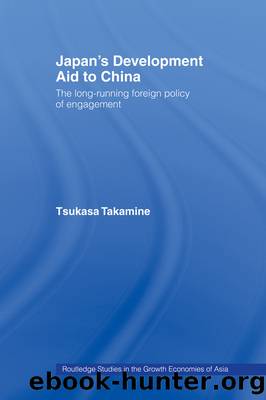Japan's Development Aid to China by Tsukasa Takamine

Author:Tsukasa Takamine [Takamine, Tsukasa]
Language: eng
Format: epub
Tags: History, Asia, General, China, Japan, Social Science, Ethnic Studies, Regional Studies
ISBN: 9781134263653
Google: mn27WbxghwEC
Publisher: Routledge
Published: 2012-11-12T15:54:49+00:00
Aid Diplomacy: Background and Practice
Before proceeding to the case studies, it is necessary to explain why Japanese governments first began to impose ODA sanctions in response to particular Chinese military actions. Three major factors encouraged the use of ODA as a strategic weapon against the Chinese government. They were, first, the resurgence of the strategic rivalry between Japan and China following the collapse of the Soviet Union; second, the shift of policy-making power from Foreign Ministry bureaucrats, with their traditionally non-confrontational diplomatic approach towards the PRC, to LDP politicians, who tend to prefer a more straightforward diplomacy; and third, the change in Japanese policy-makersâ and China specialistsâ perceptions of a rapidly modernising China. As the first two factors were discussed in Chapters 3 and 4 respectively, this section mostly focuses on the third factor.
Changing perceptions of a militarily modernising China constitute a key factor that has encouraged Japanese governments to use ODA to deter Chinaâs military development, which progressed rapidly in the last decade of the twentieth century. As briefly mentioned in the previous chapters, the growth rate of Chinaâs defence expenditure was in double figures for fourteen consecutive years since 1989. The PRCâs defence expenditure for the year 2001 was 17.6 per cent higher than that of the previous year, while that for 2002 was increased by 18 per cent compared to the previous year.1 According to The Military Balance, Chinaâs defence expenditure in 2004 is expected to increase by 11.6 per cent compared to the previous year.2 Thanks to its improved financial capability, the PLA has made great efforts to modernise its nuclear and conventional weapons since the beginning of the 1990s. The PLA has upgraded its long-range (intercontinental) and intermediate-range nuclear ballistic missile systems; enhanced its command, control, communication and information facilities; and strengthened the conventional weapons capability of its navy and air force by procuring technologically advanced warships and fighter aircrafts, mostly from Russia.3 In addition, China has been active in developing the PLAâs combat power to fight a high-tech war by integrating the PLA units with information networks and developing satellite-based communications.4 Particularly since the beginning of the 1990s, as will be shown later, Japanese governments have begun to view the sharp increase in Chinese defence expenditure very negatively.
From Japanâs perspective, Chinaâs military build-up in the 1990s is one negative consequence of that countryâs rapid modernisation over the last two decades. Economic growth and industrialisation have greatly strengthened Chinaâs financial and industrial capacity to modernise its military force. The irony, of course, is that Japan has used ODA as an instrument to apply sanctions against Chinese militarisation, which, arguably, might not have been possible in the first place without Japanese development assistance.
Rapid economic development of a nation does not necessarily lead to a speedy military build-up, as the case of post-war Japan demonstrates. Two major reasons, however, motivated the Chinese government actively and openly to implement its military development programmes, despite the strong concerns expressed by many countries in the region. The first reason was historical.
Download
This site does not store any files on its server. We only index and link to content provided by other sites. Please contact the content providers to delete copyright contents if any and email us, we'll remove relevant links or contents immediately.
| Central Asia | Southeast Asia |
| China | Hong Kong |
| India | Japan |
| Korea | Pakistan |
| Philippines | Russia |
The Sympathizer by Viet Thanh Nguyen(4336)
The Rape of Nanking by Iris Chang(4165)
World without end by Ken Follett(3445)
Ants Among Elephants by Sujatha Gidla(3439)
Blood and Sand by Alex Von Tunzelmann(3164)
Japanese Design by Patricia J. Graham(3135)
The Queen of Nothing by Holly Black(2539)
City of Djinns: a year in Delhi by William Dalrymple(2529)
Foreign Devils on the Silk Road: The Search for the Lost Treasures of Central Asia by Peter Hopkirk(2441)
India's Ancient Past by R.S. Sharma(2432)
Inglorious Empire by Shashi Tharoor(2410)
Tokyo by Rob Goss(2403)
In Order to Live: A North Korean Girl's Journey to Freedom by Yeonmi Park(2357)
Tokyo Geek's Guide: Manga, Anime, Gaming, Cosplay, Toys, Idols & More - The Ultimate Guide to Japan's Otaku Culture by Simone Gianni(2344)
India's biggest cover-up by Dhar Anuj(2333)
The Great Game: On Secret Service in High Asia by Peter Hopkirk(2313)
Goodbye Madame Butterfly(2223)
Batik by Rudolf Smend(2150)
Living Silence in Burma by Christina Fink(2047)
